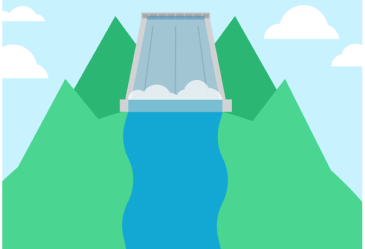Solar Panels
You’ve probably seen solar panels on top of parking structures, on radar speed displays and on rooftops around your community. These futuristic-looking, rectangular-shaped panels absorb sunlight and convert it to electricity. Instead of using traditional energy sources that aren’t very eco-friendly, you can tap into the endless power of the sun to brighten your home with clean solar energy.
And every year, thanks to improved technology and growing demand, solar panels for the home and solar panels for businesses become less and less expensive, and more and more commonplace. What may have seemed like a risky bet a decade ago is now a smart investment for many home and business owners.
Let’s take a closer look at how solar panels work, what’s available on the market today and how much it costs to install solar panels on your home.
How do solar panels work?
The science behind solar panels is complex and worth learning about. But here are the basics of the photovoltaic (Greek for “light energy”) process.
First, a few definitions to have handy:
- Photon – A light particle.
- Solar cells – The square-shaped parts that make up a solar panel, typically made from silicon. They’re composed from a positive layer and a negative layer; together, they form an electric circuit.
- Direct current (DC) – Power whose electric charge runs in one direction (think: battery-powered devices).
- Alternating current (AC) – Power whose electric charge changes directions (think: items you plug into the wall).
- Inverter – An apparatus that converts DC electricity into AC electricity.
Now, the solar panel process:
- Photons hit the solar cells of a solar panel, knocking electrons loose from their atoms.
- Those electrons of DC electricity flow through the circuit and into an inverter.
- The DC electricity is converted to AC electricity.
- This electricity is added to the energy grid to power homes and businesses.
What are the different types of solar panels?
When researching solar panels for your home, you’ve got to compare apples to apples. Two of the most popular types of residential solar panels on the market today are monocrystalline and polycrystalline.
Monocrystalline solar panels
Monocrystalline—that’s fancy talk for single-crystal silicon panels formed into bars and cut into wafers. The electrons in this type of solar panel have more room to move, making it a more efficient solar panel than a polycrystalline panel.
You can recognize a monocrystalline solar panel by its even, black color and the cut corners of each wafer.
Polycrystalline solar panels
Polycrystalline panels are—you guessed it—made from many silicon crystals melted together to form wafers. With multiple crystals in each cell, electrons have less room to move around. This means polycrystalline solar panels are less efficient than their monocrystalline counterparts, and can also burn out faster in extreme heat.
You can spot a polycrystalline solar panel by its blue hue and perfectly rectangular wafers.
How much do solar panels cost?
The cost of purchasing and installing solar panels for the home varies. It’s best to request a solar assessment to get an accurate quote for your particular home. (Go ahead—it’s free and only takes a minute to get started.)
The type of solar panel you choose can impact the price of your rooftop solar system. Monocrystalline solar panels are more expensive than polycrystalline panels because they are top-of-the-line quality with a higher efficiency rating and a more appealing look when installed on a rooftop. For these reasons, our preferred installation partners only install monocrystalline solar panels.
One way to offset the initial cost of a solar panel system is to put it to work for you. Green Mountain customers in Texas can enroll in our solar energy buy-back program, Renewable Rewards®, to get a monthly bill credit for 100% of the system’s excess energy. It’s a win-win for you and the planet.
And don’t forget about the federal solar tax credit—through 2021, you can deduct part of the solar system’s cost on your federal tax return.
Solar panel installation
The first step of solar panel installation is to get a free solar assessment to determine if rooftop solar is a good fit for your home. If it is, you’ll then work with our experts to get answers to your questions and to choose the right tier of solar panels for your needs and budget.
There’s some paperwork we’ll need to move through the proper channels, such as your city and your homeowner’s association (if applicable). This can take a few months, but we’re here to make it a smooth process for you.
Once everything is signed off on, it’s time to install—and that part usually only takes a day!
Frequently asked questions
Q: How many solar panels are needed to power a house?
A: It all depends on the size of your house. Based on 2018 data, the average size of our residential solar installations was 9.90kW. This works out to between 28 and 33 panels, depending on the type of panel. However, a free assessment will give you the most accurate estimate for your unique home.
Q: Are solar panels free?
A: Sorry, solar panels are not free. But, if your home is a strong candidate for rooftop solar, it’s an investment that should pay off in the long run.
First, there’s the federal solar tax credit (also known as the investment tax credit, or ITC). If you begin construction of your system in 2020, you can deduct 26% of the cost of a solar panel system from your federal taxes. (For systems that start construction in 2021, that percentage will drop to 22%.)
Then, there’s the savings on your electricity. After you’ve saved enough on your electricity bills to equal the cost of your initial investment, it’ll be like getting free electricity for the remainder of the life of your solar panels.
Lastly, Texas customers who choose Green Mountain can enroll in our Renewable Rewards® buy-back program. That means you’ll earn a bill credit for any excess electricity your rooftop solar system exports back to the grid.
Q: How long do solar panels last?
A: Our preferred installation partners provide a 25-year warranty.
Q: Do solar powers require maintenance?
A: Solar panels typically require very little maintenance during their lifetime. The biggest concern—dirt and debris blocking the panels from the sunlight—is usually resolved by rain and gravity. Periodic cleanings may be required in some environments.
Because warranty terms vary by installer and equipment manufacturer, it's best to consult the warranties of your solar panel installation and equipment for specifics on what maintenance issues may be covered.
Q: Do solar panels work on a cloudy day?
A: On cloudy days when there is not as much sunlight, solar panels will not produce as much electricity. However, your home can still draw regular energy from the grid at your electricity plan rate.
And don’t forget, on sunny days when your panels produce more electricity than your house is using, you’ll earn a bill credit for the excess electricity returned to the grid.
Q: Do solar panels work at night?
A: Solar panels need sunlight to generate electricity, so they don’t generate electricity at night.
But rest assured, you won’t be left in the dark. Just as you do on a cloudy day, you’ll still have access to electricity via the energy grid.
Q: What if I rent, or live in a location that doesn’t receive much rooftop sunlight?
A: Depending on your living situation, solar panels may not be the best fit. If you rent a home or apartment, live in a climate that doesn’t get a lot of sunlight, or have a lot of trees blocking the sun from your home’s roof, a solar system may not be possible or practical.
The good news? You can still support the growth of solar power even if you don’t get solar panels installed on your roof. When you sign up for the SolarSPARC® (Smart People Accelerating Renewable Change) electricity plan, Green Mountain sets aside money each month on your behalf to fund projects, programs and solar-related technologies that help make this renewable energy source even more affordable.







